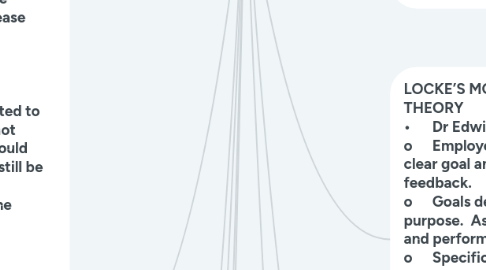Managing Employees
by Ava _q

1. Locke and Latham set out 5 principles that should be applied when setting goals for employees: 1. Clarity o Goals should be simple, clear and specific as possible o Providing a measurable requirement such as “increase sales by 5%” is better than “improve sales”. 2. Challenge o Employees are motivated to achieve things they have not achieved before. Goals should extend the employee, but still be achievable. o Otherwise it sets up the employee for failure. 3. Commitment o If an employee is more committed to a goal, they are more likely to be motivated to achieve it. They are more likely to commit if they have been involved in setting the goal. o As such, a manager should use a participative or consultative style to involve the employee in the goal setting process. 4. Feedback o Feedback provides the opportunity to provide recognition of successes and adjust the goal where necessary. This can be formal or informal. 5. Task complexity o Goals should not be too complex, otherwise it will overwhelm the employee. o Deadlines should be realistic. • The Four Drives Theory was developed by Dr Paul Lawrence and Dr Nitin Nohria from the Harvard Business School. • Their theory states that there are 4 fundamental things that drive human behaviour. • These 4 drives can be used to understand what needs to be done to improve the motivation of employees.
2. The drive to comprehend • The desire to learn new skills and explore the unknown • In the workplace: a) Opportunities to learn new skills are provided on a regular and ongoing basis. b) Tasks are made as interesting as possible. c) Employees feel that they are gaining additional skills and valuable experience as they go about their daily work.
3. The drive to bond • The desire to form relationships with other people and groups • In the workplace: a) Managers and leaders will be people oriented and will seek to interact with all employees in a positive and encouraging manner. b) Teamwork and collaboration will be encouraged and recognized, and collective achievements highly valued. c) Sharing of best management practice amongst employees will be rewarded and staff will be encouraging to support the team culture.
4. Termination management, including entitlement and transition issues: - retirement – retirement is when an employee voluntarily leaves the workforce and the workforce. Businesses now support those in the process of retirement - redundancy - Redundancy occurs when a person’s job no longer exists, usually due to technological changes, a business restructure or a merger or acquisition. - retrenchment - Retrenchment occurs when a business dismisses an employee because there is not enough work to justify paying them. - resignation - Resignation is the voluntary ending of employment by the employee ‘quitting’ their job. - dismissal - Dismissal occurs when the behaviour of an employee is unacceptable and a business terminates their employment.
5. Awards and agreements to determine wages and work conditions Collective bargaining - Collective bargaining involves determining the terms and conditions of employment through direct negotiation between unions and employers. Enterprise agreement - An enterprise agreement is an agreement that has been directly negotiated between the employer and employees at the enterprise level. Penalty rates - Penalty rates are additional wages paid to employees who work outside of normal working hours.
6. MASLOW’S MOTIVATIONAL THEORY • Abraham Maslow (1908-1970) • Was a psychologist that believed: o all people have needs that need to be satisfied AND o that they will work towards meeting those needs. o Using these assumptions, he came up with a theory to explain what motivates people – this in turn has been applied to business practice
7. LOCKE’S MOTIVATIONAL THEORY • Dr Edwin Locke (1960’s) o Employees are motivated by clear goal and appropriate feedback. o Goals develop a sense of purpose. As a result, motivation and performance improves. o Specific and challenging goals lead to better performance. o Goals need to be challenging but not too challenging! (achievable) o Employees are more motivated to achieve goals they have helped to set.
8. The drive to defend • The desire to remove threats to our safety and security • In the workplace: a) Managers treat all employees fairly and are seen to do so consistently. b) The workplace is welcoming and supportive, and intimidation is not used as management technique. c) Managers and leaders foster an atmosphere of trust, by ensuring they are consistent and honest in all dealings with employees
9. Role of different participants in workplace relations Human resource managers - The role of human resource managers in the employee relations environment includes negotiating employment agreements, training other managers and supervisors to facilitate the implementation of agreements within their areas of responsibility, ensuring the implementation of all key terms of agreements and dealing with disputes and conflict that may arise during the life of an agreement Trade unions - Trade unions are organisations formed by employees in an industry, trade or occupation to represent them in efforts to improve wages and the working conditions of their members. Employer associations - Employer associations are organisations that represent and assist employer groups.


